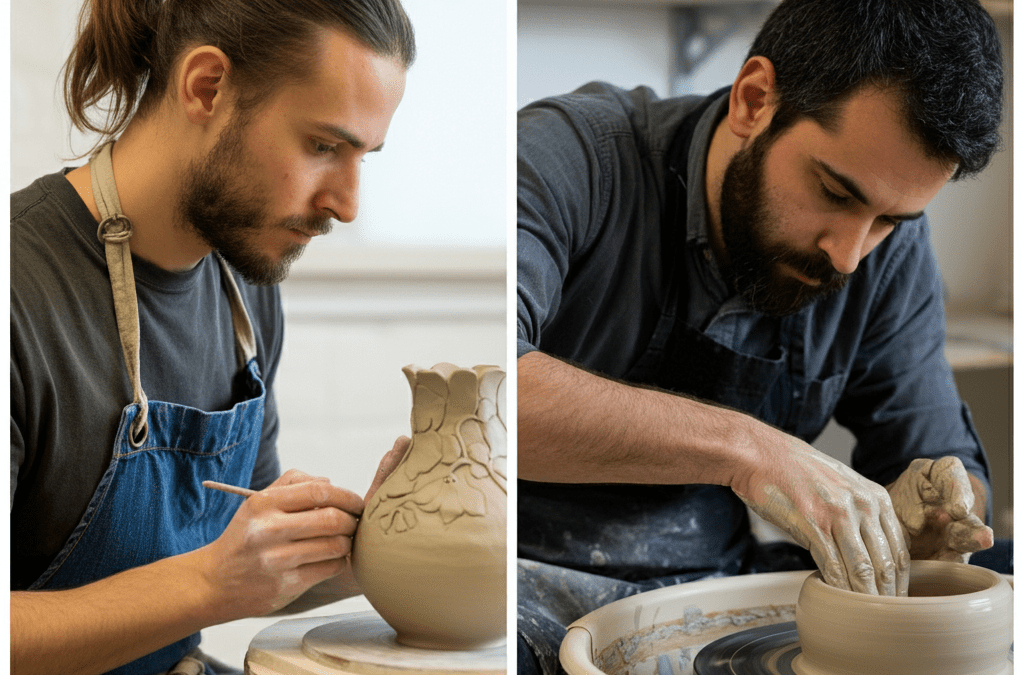
Ceramic and pottery artists at Charles Street Studios, Bergen County NJ, rent monthly studio space to pursue their singular artistic visions whether they focus on hand-building or wheel throwing or some combination of the two. Charles Street Studios offers all of the equipment you need regardless of your approach to making beautiful and unique ceramic creations. Regardless of the approach you take, Charles Street Studios is the place ceramic artists bring their visions to life. To learn more about the differences and advantages of each style of pottery making read on.
Hand-Building vs. Wheel Throwing: Exploring the Art of Ceramic Creation
Ceramics have been a part of human culture for thousands of years, serving both functional and artistic purposes. Two primary methods of creating ceramic structures are hand-building and wheel throwing. Each technique has its own unique history, advantages, and appeal, attracting different artists for various reasons. In this blog post, we will delve into the differences between these methods, their historical backgrounds, and why some artists prefer one over the other.
The History of Hand-Building and Wheel Throwing
Hand-Building is one of the oldest methods of creating ceramics, dating back to ancient times. Early humans used their hands to shape clay into functional objects like pots, bowls, and figurines. Techniques such as pinching, coiling, and slab building were developed to create more complex forms. Hand-building allowed for a high degree of creativity and individuality, as each piece could be uniquely shaped and decorated.
Wheel Throwing, on the other hand, emerged around 3000 BCE in Mesopotamia. The invention of the potter’s wheel revolutionized ceramic production, allowing for faster and more symmetrical creations. The wheel enabled potters to produce uniform vessels with greater precision and efficiency. This method quickly spread across cultures and became a staple in ceramic production, particularly for functional items like plates, cups, and storage jars.
Differences Between Hand-Building and Wheel Throwing
1. Technique and Process:
- Hand-Building: This method involves shaping clay using hands and simple tools. Techniques include pinching (forming shapes by pinching the clay), coiling (rolling clay into long ropes and stacking them), and slab building (rolling out flat pieces of clay and assembling them). Hand-building allows for a more tactile and intimate connection with the material.
- Wheel Throwing: Involves using a potter’s wheel to shape clay. The clay is centered on the wheel, and the potter uses their hands and tools to form the desired shape as the wheel spins. This method requires a good sense of timing and coordination to achieve symmetrical forms.
2. Creative Freedom:
- Hand-Building: Offers greater creative freedom and flexibility. Artists can experiment with asymmetrical shapes, textures, and intricate details that might be challenging to achieve on a wheel. This method is ideal for sculptural and decorative pieces.
- Wheel Throwing: While it provides precision and uniformity, wheel throwing can be more limiting in terms of shape and design. However, it excels in creating functional items with consistent dimensions.
3. Skill Level:
- Hand-Building: Generally more accessible for beginners. It requires basic tools and techniques that can be easily learned. Artists can take their time to refine their pieces without the pressure of the wheel’s speed. However do not be mislead, many advanced and highly skilled ceramic artists create spectacular and unique creations with only their imagination limiting them.
- Wheel Throwing: Requires much practice and skill to master. Centering the clay and maintaining control over the shape while the wheel spins can be challenging for novices. However, with practice, it becomes a highly efficient method with the possibility to create sophisticated ceramic art work that cab ne both functional and beautiful.
Advantages of Each Method
Hand-Building:
- Versatility: Allows for a wide range of shapes and designs, from organic forms to intricate sculptures.
- Personal Touch: Each piece is unique, reflecting the artist’s individual style and creativity.
- Accessibility: Requires minimal equipment, making it accessible for home studios and beginners.
Wheel Throwing:
- Efficiency: Ideal for producing multiple pieces with consistent shapes and sizes.
- Precision: Enables the creation of symmetrical and balanced forms, perfect for functional ware.
- Speed: Once mastered, wheel throwing can be faster than hand-building for certain types of items.
Why Artists Prefer One Method Over the Other
The choice between hand-building and wheel throwing often comes down to personal preference and artistic goals. Some artists are drawn to the tactile and meditative nature of hand-building, enjoying the freedom to experiment with shapes and textures. Others appreciate the precision and efficiency of wheel throwing, especially when creating functional items. Ultimately, both methods offer unique opportunities for creativity and expression. Whether you prefer the hands-on approach of hand-building or the rhythmic motion of wheel throwing, the world of ceramics provides endless possibilities for artistic exploration.
At Charles Street Studios, we celebrate the diversity of ceramic techniques and encourage artists to explore both methods. Whether you’re a seasoned potter or a beginner, there’s always something new to discover in the art of ceramics. Your creative journey deserves a dedicated space—one where clay meets inspiration, uninterrupted by the noise of everyday life. Visit Charles Street Studios today.
Charles Street Studios – The Place to Create in Bergen County

